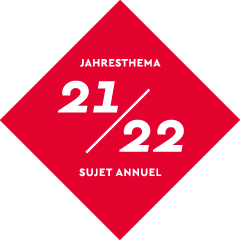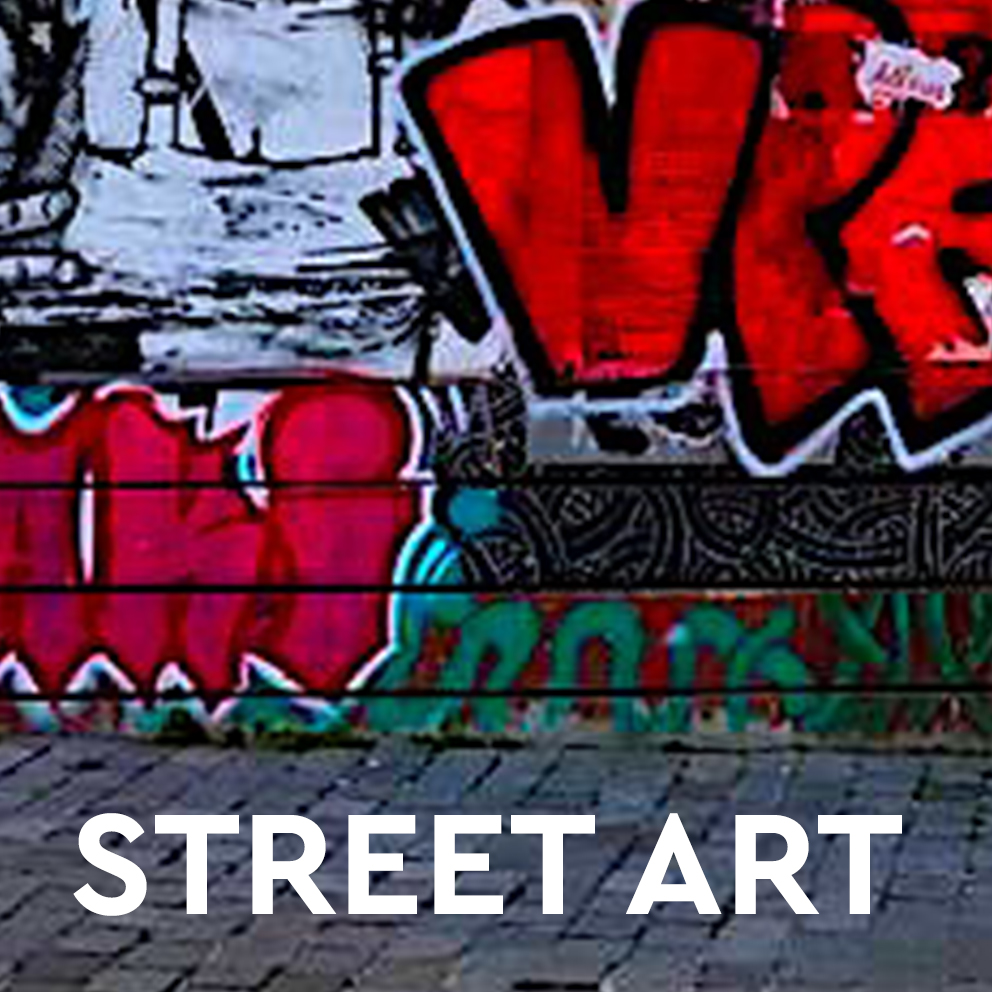Annual theme 21/22 – Street Art
Street Art
The terms street art and urban art encompass various means by which artists have intervened, since the 1960s, in the animation of urban public spaces, through attempts to counteract the monotony of cities, their inhospitable character, and their continuously deplored transformation into commercial zones. This art form is inextricable from the question of the actors to whom urban public spaces belong. This question has been brought to the fore at the level of politics, through the struggles for the democratization of western society since the sixties, as well as at the level of academic research, through debates around public space that are no less political. The authorized forms that structure urban space are opposed by unauthorized forms—graffiti being the most common among these—which aim at a spatial reappropriation that is at once subversive and ironic. Taggers, coming from young subcultures, are a particular expression of this: especially fond of means of public transit—trains, subways, trams, buses—as supports for their ornamental forms and their graphic inscriptions, they often develop a personal language intelligible only to insiders.
These illicit forms have been accompanied by a radical questioning of the operations of the art world. Indeed, these works are not intended to last and thus problematize the very basis of the art market. The anonymous character of street artists and collectives and the tendency to work under pseudonyms challenge the principle of authorship. As a result, street art has found itself at the heart of debates about art and its social significance, and the forms it has engendered have had a lasting influence on developments in contemporary art. It is this theme that is being undertaken, starting September 1, 2021, within a group of researchers at the DFK Paris, accompanied by Thomas Kirchner (DFK Paris) and Claire Calogirou (associate researcher at the Musée des Civilisations de l’Europe et de la Méditerranée [Mucem] and the Institut d’ethnologie méditerranéenne, européenne et comparative [IDEMEC] / Centre national de la recherche scientifique [CNRS]).
Referent Professor: Claire Calogirou
Doctorate in urban ethnology, associate researcher at IDEMEC/CNRS Research specialization in cultures linked to the urban environment, developing a set of problematics around the relationship between popular cultures and learned cultures; the transmission of knowledge; identity-related and aesthetic questions; and material and immaterial culture. Research and collection-building for Mucem on skateboarding (1992-2001) and hip-hop and graffiti (since 1999). Curator of exhibitions on skateboarding, hip-hop, and graffiti. Numerous university-level teaching engagements, conferences, and publications. Teacher at the École du Louvre.
Research Projects of the Fellows of the Annual Theme 2021/22 “Street Art”
Dr. Cristóbal F. Barria Bignotti
Doctorate in art history, Universitá degli Studi di Roma “La Sapienza,” Rome, Italy
Transnational Mapping of Chilean Mural Brigades
This project aims to study the transnational distribution of the works of the Chilean muralist brigades. To this end, it seeks to constitute a digital archive of works realized in different parts of the globe and to develop a computer tool that allows us: 1) to geolocate the images; 2) to organize them according to theme, author, dimensions, and iconography; and 3) group them into clusters created by digital representation. This platform is intended to be open access so that other researchers can develop studies on street art from other perspectives, including town-planning, sociological, iconographic, and thematic studies, and so forth. The group of muralist collectives known first as the Ramona Parra Brigades was founded in 1968 under the Chilean Communist Party with the primary objective of producing political propaganda for Salvador Allende’s presidential campaign. Under the government of the socialist president, the different collectives diversified and transformed into cultural actors of great national importance, developing a distinctive aesthetic that has come to characterize the period of popular unity (Baumann, 2014; Canto Novoa, 2012; Castillo, 2016; Fontaine, 2014; Garcia, 2005; Lemouneau, 2019; Sandoval, 2001). With the coup d’état of September 11, 1973, the members of these brigades were forced into hiding or into exile abroad. In either case, they continued to practice their art under these new conditions.
Sabrina Dubbeld
Doctorate in the history of contemporary art (Université Paris-Nanterre) and associate researcher in laboratory EA4414 (HAR, Histoire des arts et des représentations, Université Paris-Nanterre)
From the Call of the Wall to Artivism: When Graffiti Becomes “Writing As An Event”. Critical Perspectives on the Parisian and Athenian Graffiti Scenes Today
This research project aims to interrogate, from a new angle, the political and militant dimension that graffiti can assume in public space by focusing more specifically on productions that participate in a “writing event.” Two fields are essential to this investigation, on account of their socio-political resonances as well as the many cultural and artistic transfers that operate within them: namely, the Parisian and Athenian scenes, which over the past five years have been at the heart of major revolutionary writing events.
Simon Grainville
Doctoral student in history of art, Université Paris Nanterre, under the direction of Professor Thierry Dufrêne. Thesis: “Espace, frontière de l’infini : Imaginaires science-fictionnels et esthétique spatiale dans le graffiti français et américain”
Space, Frontier of Infinity: Science-Fictional Imaginaries in French Graffiti from the 1980s to the Present
Published in 1984, the book Subway Art, “the bible of graffiti” is a manifesto. Through the photographs of Martha Cooper and Henry Chalfant, a generation of graffiti artists – who made MTA a space of creation in perpetual motion – was immortalized: Zephyr, Kase 2, Lady Pink, Dondi, etc. Nevertheless, if graffiti (or rather, writing) is intrinsically linked to handwriting and the limits of its script, the letters of the graffiti artists are quickly accompanied by decorations, characters, and accessories allowing for the establishment of a figurative visual universe. The cryptic character of writing is therefore counterbalanced by a galaxy of references from popular culture, enabling all to apprehend this new, “wild” art form. How might we explain the development of this specific imaginary? One can answer briefly with a list of works and artists who have come to make their mark on the popular culture of this period by renewing science-fictional imaginary. Generational films abound: the first Star Wars trilogy (1977-83), Alien (1979), Mad Max (1979), Blade Runner (1982), Tron (1982), Dune (1984), and Terminator (1984).
Jordan Hillman
Doctoral candidate in the history of modern European art, University of Delaware, Newark. Dissertation: “Mediating Authority: Representations of the Police in Paris circa 1900 (Advisor: Dr. Margaret Werth)”
Mediating Authority: Representations of the Police in Paris circa 1900
Ultimately, my dissertation examines how avant-garde forms of visual production opposed authorized forms that structured the urban space of Paris, namely the police. The pictures produced by Steinlen, Vallotton, Grün, and others aimed at a reappropriation of the official police image that was both subversive and ironic. In their depiction of, and display within, the street, these artists further undermined modern constructions of state power that sought to shape and control urban space. Through a mobilization of new, reproductive modes of image making and their circulatory potential, these critical images of police in Paris worked against monolithic notions of authority, exposing faults in the presumed power and legitimacy of the police force. At the same time, the intermedial, avant-garde, and popular production of these artists oscillated between rejection and affirmation with the art world. In challenging both established hierarchies of representation and authority, the artists at the center of my dissertation participated in fundamental debates about art and its social significance that anticipated the countercultural power of images a near century before the codification of the term street art in the 1960s.
Sara Martinetti
Doctorate in arts, history, and theory, École des hautes études en sciences sociales, Paris
The writing practices of Daniel Buren, Michel Claura, and others on the Parisian art scene of the 1970s
In 1968 Daniel Buren started his series of Affichages sauvages (Wild Posterings), of which Michel Claura wrote in an article published in 1970 in Studio International: “There were thus a basic visibility, to which every passer-by was a witness, and a specific visibility of which those who came specifically to see in response to the announcement were spectators.” In the 1970s, both the artist and the critic played an active part in an informal network that congregated in alternative Parisian venues such as Galerie 1-36 or Vitrine pour l’art contemporain, which attracted figures from different backgrounds whose work and influence largely remain to be charted. The Polish photographer Eustache Kossakowski (1925-2001) has produced an exceptional documentation of this milieu and created several photographic series, such as Six mètres avant Paris (Six Meters before Paris) and Les Palissades, which take the contemporary viewer into the streets of the capital in those years. Based on this collection of works, writings, ideas, places, situations, and people, I will use an anthropological approach to research the relationships between so-called Conceptual Art and street art. Both practices share the urban terrain as a space for art outside the traditional gallery, a preference for onsite work, and a political stance that fed into their critique of institutions and writing practices. Secondly, my work will focus on developing a research tool for Claura’s writings in order to highlight the theoretical concerns he shared with the people with whom he collaborated in this context.


Lectures of the Annual Theme 2021/22 “Street Art”
Mardi 19.10.2021, 18h-19h30
Larissa Kikol (Kunstkritikerin und Freelance Forscherin)
»Graffitis – Ein diffuser Nebel in der Kunstwelt«
Mardi 16.11.2021, 18h-19h30
Claire Calogirou
»Graffiti-Forschung und -Sammlung im Mucem«
Mardi 07.12.2021, 18h-19h30
François Chastanet (Architekt, Graphikdesigner und Typograph, Mitbegründer des Ateliers TypoMorpho)
»Sechs Schriften der Weltstadt«





